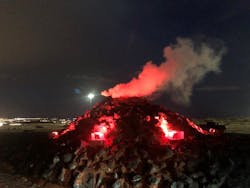A Volcanic Purpose
About the author:
Kimberly Paggioli is vice president of marketing and quality control for Hobas Pipe USA. Paggioli can be reached at [email protected].
Although erupting volcanoes are not often associated with positive results, the Albuquerque Metropolitan Arroyo Flood Control Authority (AMAFCA) is proud of its man-made volcano, which uses a natural phenomenon to solve an age-old problem. Powered by gravity and storm water, the West I-40 Diversion Channel Phase IV Project—nicknamed the “Stormwater Volcano”—was designed and constructed to capture, divert and treat storm water runoff from the north side of U.S. Interstate 40 from the top of the Nine Mile Hill east to the Rio Grande River.
The inspiration for the volcano when local engineering and architectural firm Wilson & Co. brainstormed with AMAFCA. Tyler Ashton, P.E. & CFM for Wilson & Co., said the idea was adopted because a volcano was an ideal fit for the location just below three dormant volcanoes that overlook the west side of Albuquerque.
The shape and stature of a volcano also complemented the Interstate Corridor Enhancement Plan (ICEPlan)—a conceptual framework created by the city of Albuquerque with the New Mexico State Highway and Transportation Department, as well as residential areas, businesses and civic organizations—to enhance the gateway into Albuquerque at the crossroads of two interstates. This section of I-40 is known as El Pedregal, which means “The Stony Place.”
“The volcano was constructed of concrete, but basalt rocks were set into the surface to give it a more natural appearance,” said Jerry Lovato, P.E., executive engineer for AMAFCA.
Installation & Construction
Placing an obstruction in a high-velocity channel can be difficult.
“At first we didn’t know if the volcano idea was going to work,” Ashton said. “Before design started, we worked closely with AMAFCA and the University of New Mexico Hydraulics Lab to erect a 1:36 scale model to make sure water stayed in the channel. Fortunately, the model worked.”
Various sizes of standard centrifugally cast, glass-fiber-reinforced, polymer mortar Hobas pipe were selected to facilitate the volcano design. Although it is a gravity system, internal pressures exceeded standard storm drain pipe capacities. Because of the low roughness coefficient of its smooth inner surface, the pipe is well-suited for almost all abrasion-resistant hydraulic piping applications. In all, the storm water volcano contains 700 ft of 48-in. pipe, 15 ft of 30-in. pipe, and 150 ft of 18-in. pipe. Special Hobas fittings and a custom-built reducer enabled the pipes to feed into the bottom of the volcano.
“To mimic lava flow, the concrete was tinted red and black and pneumatically applied, using high-pressure air, which gives the surface a coarse, pumice-stone texture,” Lovato said. “We like that type of texture because it decreases graffiti and discourages skateboarders. It also creates friction for the water flow and reduces splashing and run-up waves. Hydraulically, the pneumatically-applied concrete—or “shotcrete”—produces a very rough surface.”
Positioned on an island and flanked by a 6-ft-deep channel on either side, the volcano sports a 50-ft-diameter base and a top that measures 10 ft in diameter. The structure rises 12 ft from the bottom of the island or 18 ft from the bottom of the channel.
“This flood control project is an asset because it protects the freeway and homes, but it’s also an asset to the community,” Lovato said. “The volcano is designed to prevent flooding, but it also offers something visual and addresses storm water quality by introducing oxygen into storm water.”
Community Impacts
Completed in April 2018, the project finished more than 6,000 ft of multi-use trail, facilitating a complete loop around several of the surrounding subdivisions. In doing so, the length of the master-planned I-40 trail was extended. Lovato also was pleased with the educational aspect of the entire project.
“We basically allow the general public to enjoy walking along the trail,” he said. “Albuquerque only gets about 9 in. of precipitation a year. Every time there’s a big rain event, water will come through the volcano and they are able to see how water is aerated through the volcano structure and the amount of trash and debris collected downstream.”
To make the storm water volcano even more attractive to pedestrians and freeway travelers, Nolan Bennett, P.E., field engineer for AMAFCA, incorporated programmable LED lights to produce a light show every hour on the hour at night.
“Depending on the season, the light colors change,” Ashton said. “For example, the lights are green for St. Patrick’s Day, red white and blue for July 4th, and orange and black for Halloween. Whenever the water erupts, the pattern changes.”
Lovato said the volcano has been “a big hit” with the community. “Usually, when you have LED lights and an exposed project, you’re going to have graffiti and vandalism. None of that has happened on this project. People like it and they are taking good care of it.”
Before the diversion project was completed, the natural water course would actually continue downstream, crossing I-40, into the valley floor, which would cause flooding, Lovato said.
“Our [U.S.] EPA NPDES discharge permit provided an opportunity to have fun, by allowing a bubbling volcano to be constructed, to increase dissolved oxygen in storm water before is it discharged into the Rio Grande,” he added. “Now the water along the freeway is diverted, cleaned, and aerated before it is discharged into the Rio Grande.”
Ashton said once the full build-out is finished upstream, the model predicts the eruption should be 6 to 8 ft above the top of the volcano in the event of a 100-year storm. So next time it rains in the high desert of New Mexico, do not be surprised to hear that the world’s first storm water volcano has erupted.
